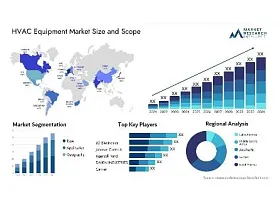According to the latest BCC research study, the demand for Heating, Ventilation and Air Conditioning: Global Markets expected to grow from $263.6 billion in 2023 and will reach $346.7 billion by the end of 2028 at a compound annual growth rate (CAGR) of 5.6% from 2023 through 2028.
This report examines the HVAC market by product type (heating, ventilation, and cooling equipment), installation type, application, and region (North America, Europe, Asia-Pacific, and Rest of the World). It reviews leading companies, their products, and revenue, along with a patent analysis. The study also covers ESG factors, emerging technologies, and the competitive landscape, including the impact of the Russia-Ukraine war. Using 2022 as the base year, the report provides estimated market values for 2023 and forecasts from 2023 to 2028, with growth rates in millions of dollars.
Some Interesting Facts about Heating, Ventilation and Air Conditioning: Global Markets
- U.S. consumers spend over $10 billion a year on HVAC repairs and maintenance, and this demand is expected to grow by 1.5 times by 2028.
- In the EU, heat pump sales are projected to more than double, from 3 million units in 2022 to 7 million units by 2030.
- Upgrading to advanced HVAC systems can cut energy use by 50%, and integrating AI and IoT can save an additional 20-25% on electricity.
Factors contributing to this growth include:
- Expansion of industrialization.: The expansion of industrialization means more factories and advanced technology for making goods. This leads to more jobs and better infrastructure like roads and power supplies. People move to cities for work, boosting economic growth and improving living standards. However, it also causes environmental challenges like pollution, which require careful management. Overall, it's about growing industries and economies, changing how people live and work.
- Construction boom.: A construction boom is a period when a lot of new buildings and infrastructure projects are being built. This includes homes, offices, roads, and bridges. It's usually driven by economic growth, increased investment, and rising demand for housing and commercial spaces. During a construction boom, there are more jobs, more development, and often a noticeable change in the landscape of cities and towns.
- Technological developments in HVAC systems.: Technological developments in HVAC systems have made them more efficient, smarter, and better for the environment. New systems use less energy, saving money and reducing emissions. Smart controls allow users to adjust settings remotely with smartphones, while AI and IoT integration helps systems learn preferences, predict maintenance needs, and optimize performance. Improved filters and ventilation also enhance indoor air quality, making spaces healthier and more comfortable.
Market Segmentation
Heating, Ventilation and Air Conditioning: Global Markets Can Be Categorized into Various Segments:
- Market Segments by Product Type
The HVAC market is categorized by product type, including heating equipment like boilers, furnaces, heat pumps, space heaters, and others. Ventilation equipment consists of air filters, air handling units (AHUs), air purifiers, humidifiers, ventilation fans, and others. Cooling equipment includes chillers, air conditioners, water cooling towers, and other cooling devices. These categories help organize the various components and systems that make up the HVAC industry, making it easier to understand and analyze.
- Market Segments by Installation Type
HVAC systems are installed in two main ways: new construction and retrofitting or replacement. New construction refers to installing HVAC systems in newly built structures, such as homes, offices, or commercial buildings. Retrofitting and replacement involve upgrading or replacing existing HVAC systems in older buildings to improve efficiency, performance, or to meet updated regulations or standards. This distinction helps understand how HVAC systems are integrated into different types of buildings and projects.
- Market Segments by Application
HVAC systems are used in various settings, categorized by their application: residential, industrial, and commercial. Residential applications involve heating, cooling, and ventilating homes and apartments. Industrial applications refer to HVAC systems used in factories, warehouses, and other industrial facilities to regulate temperature and air quality for manufacturing processes. Commercial applications include HVAC systems in offices, retail stores, restaurants, and other commercial buildings to create comfortable and healthy indoor environments for employees and customers. These categories help understand where and how HVAC systems are used across different types of spaces.
Some of the Key Market Players Are:
- CARRIER
- DAIKIN INDUSTRIES LTD.
- EMERSON ELECTRIC CO.
- GREE ELECTRIC APPLIANCES INC. OF ZHUHAI
- HITACHI LTD.
- JOHNSON CONTROLS
- LENNOX INTERNATIONAL INC.
- MITSUBISHI ELECTRIC CORP.
- NORTEK GLOBAL HVAC
- RHEEM MANUFACTURING CO.
- SAMSUNG HVAC LLC.
- TRANE TECHNOLOGIES PLC
Read More
